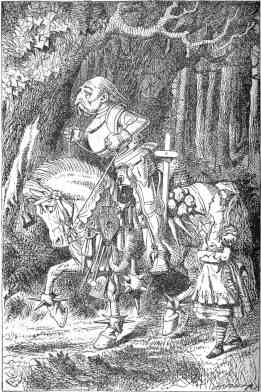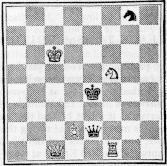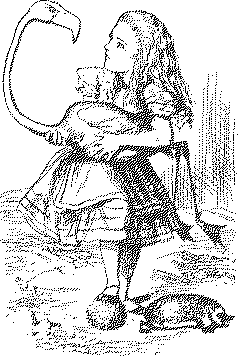| 1. | Alice meets R. Q. | R. Q. to K. R’s 4th |
| 2. |
Alice through Q’s 3d (by railway) to Q’s 4th (Tweedledum and Tweedledee). |
W. Q. to Q. B’s 4th (after shawl). |
| 3. | Alice meets W. Q. (with shawl). | W. Q. to Q. B’s 5th (becomes sheep). |
| 4. | Alice to Q’s 5th (shop, river, shop). | W. Q. to K. B’s 8th (leaves egg on shelf). |
| 5. | Alice to Q’s 6th (Humpty Dumpty). | W. Q. to Q. B’s 8th (flying from R. Kt.). |
| 6. | Alice to Q’s 7th (forest). | R. Kt. to K’s 2nd (ch.). |
| 7. | W. Kt. takes R. Kt. | W. Kt. to K. B’s 5th. |
| 8. | Alice to Q’s 8th (coronation). | R. Q. to K’s sq. (examination). |
| 9. | Alice becomes Queen. | Queens castle. |
| 10. | Alice castles (feast). | W. Q. to Q. R’s 6th (soup). |
| 11. | Alice takes R. Q. & wins. |
Preface to 1896 Edition

As the chess-problem, given on the previous page, has puzzled some of my readers, it may be well to explain that it is correctly worked out, so far as the moves are concerned. The alternation of Red and White is perhaps not so strictly observed as it might be, and the “castling” of the three Queens is merely a way of saying that they entered the palace; but the “check” of the White King at move 6, the capture of the Red Knight at move 7, and the final “checkmate” of the Red King, will be found, by any one who will take the trouble to set the pieces and play the moves as directed, to be strictly in accordance with the laws of the game.
The new words, in the poem “Jabberwocky”, have given rise to some difference of opinion as to their pronunciation: so it may be well to give instructions on that point also. Pronounce “slithy” as if it were the two words “sly, the”: make the “g” hard in “gyre” and “gimble”: and pronounce “rath” to rhyme with “bath”.
For this sixty-first thousand, fresh electrotypes have been taken from the wood-blocks (which, never having been used for printing from, are in as good condition as when first cut in 1871), and the whole book has been set up afresh with new type. If the artistic qualities of this re-issue fall short, in any particular, of those possessed by the original issue, it will not be for want of painstaking on the part of author, publisher, or printer.
I take this opportunity of announcing that the Nursery “Alice”, hitherto priced at four shillings, net, is now to be had on the same terms as the ordinary shilling picture-books—although I feel sure that it is, in every quality (except the text itself, in which I am not qualified to pronounce), greatly superior to them. Four shillings was a perfectly reasonable price to charge, considering the very heavy initial outlay I had incurred: still, as the Public have practically said, “We will not give more than a shilling for a picture-book, however artistically got-up,” I am content to reckon my outlay on the book as so much dead loss, and, rather than let the little ones, for whom it was written, go without it, I am selling it at a price which is, to me, much the same thing as giving it away.
Christmas, 1896

